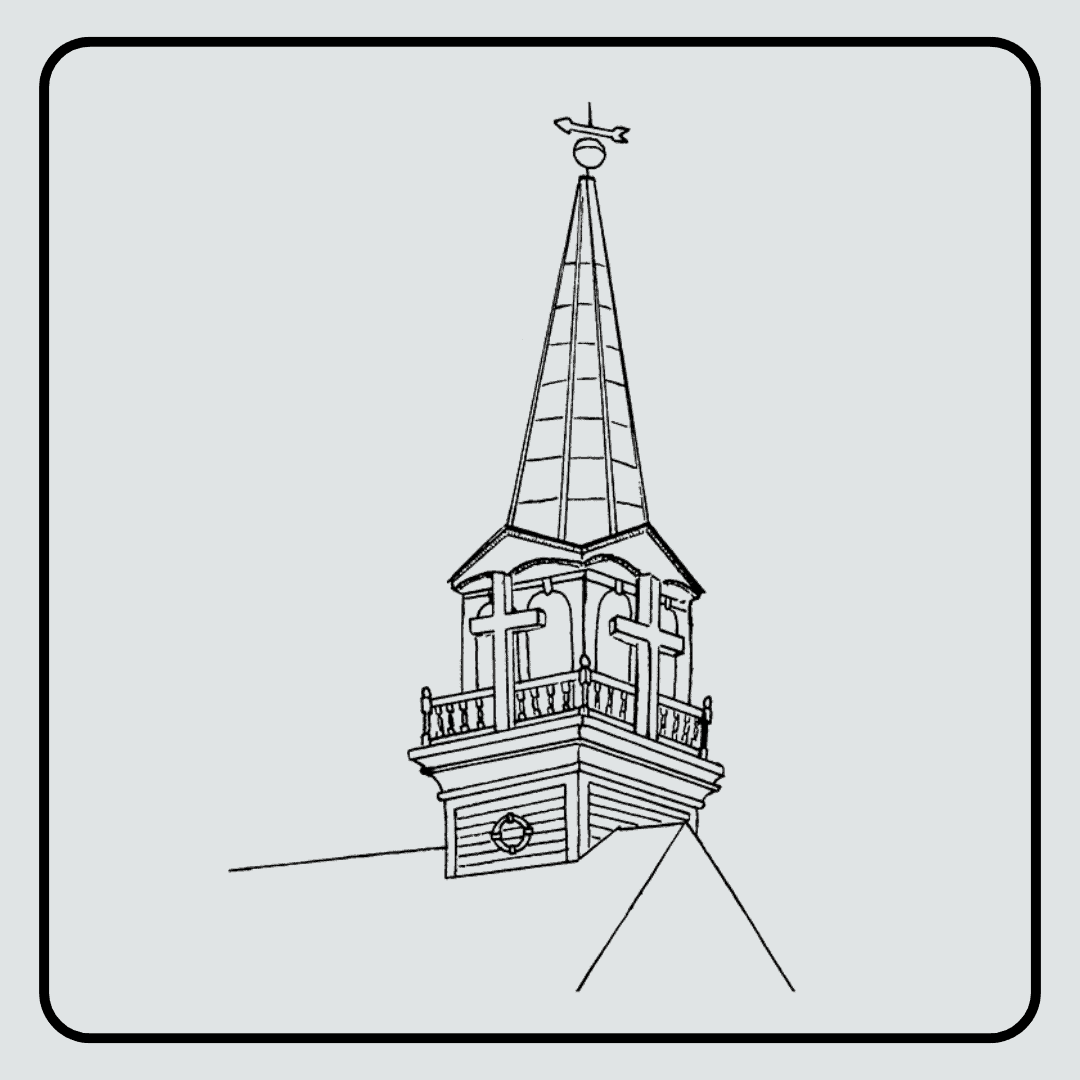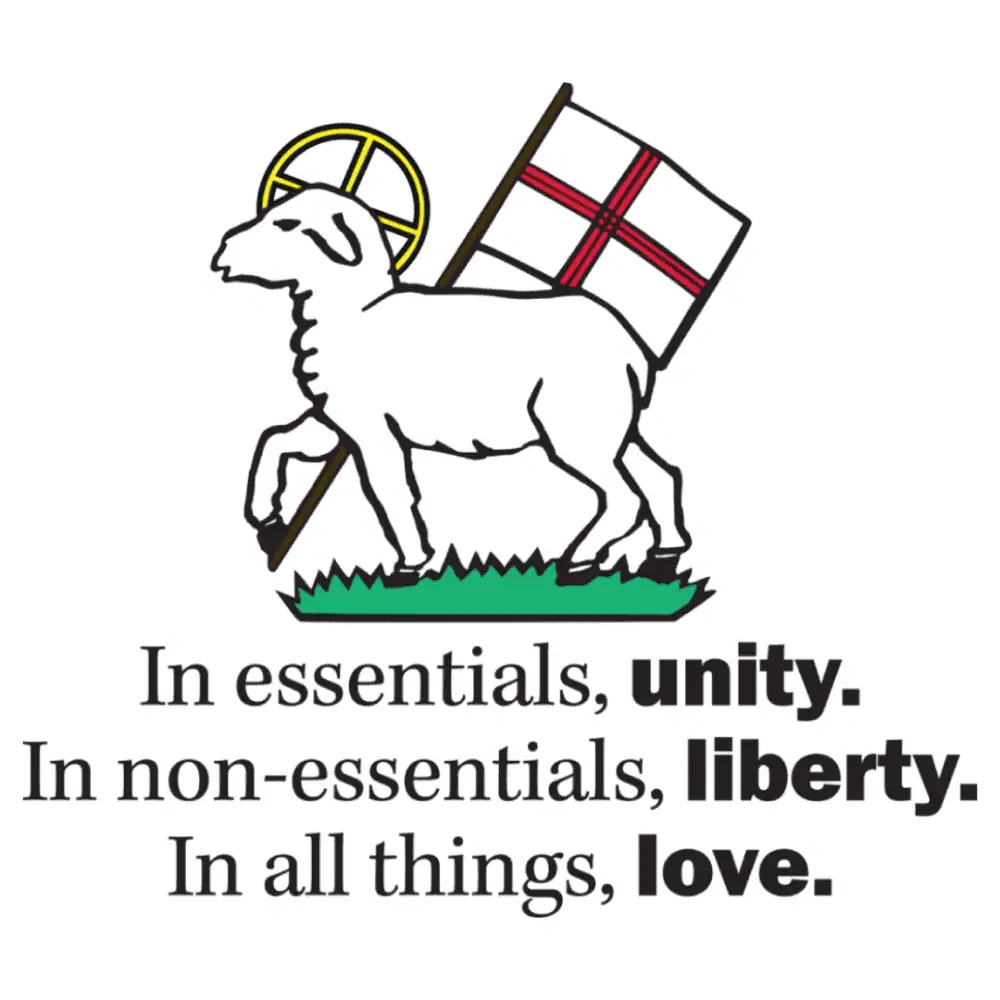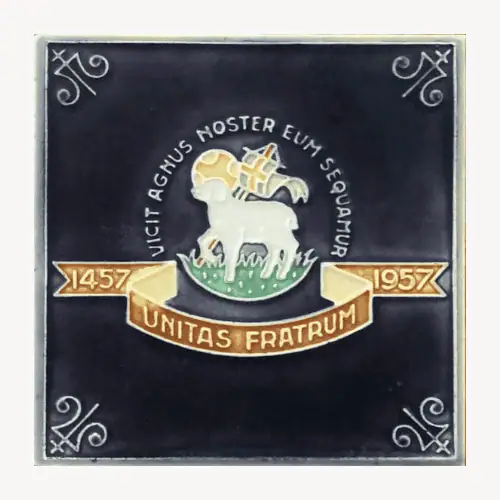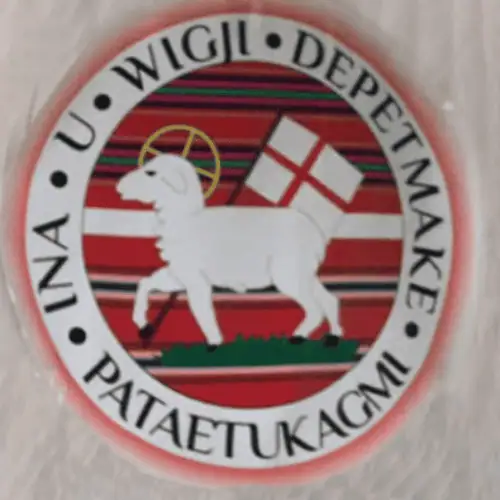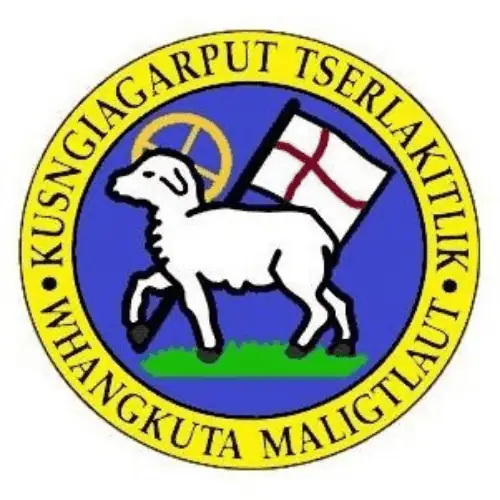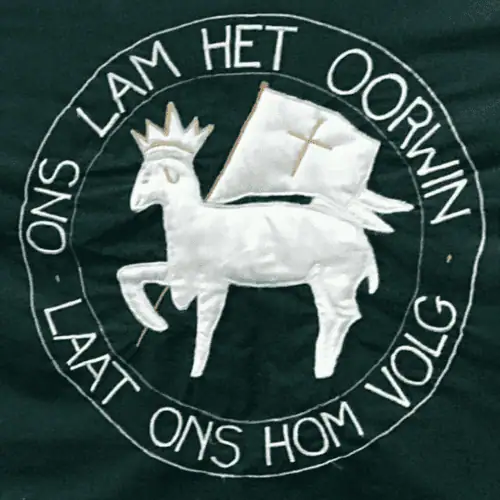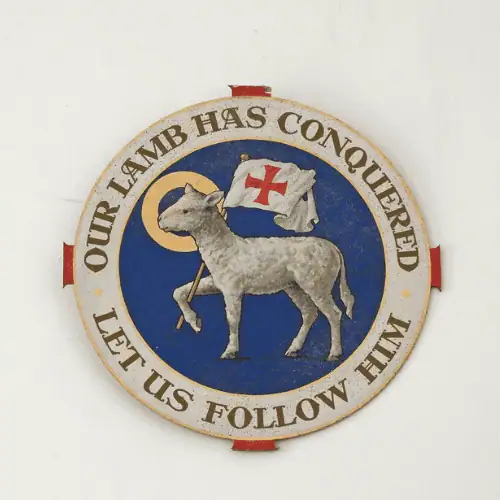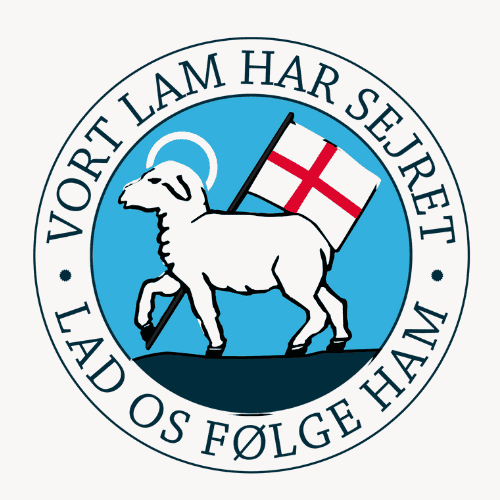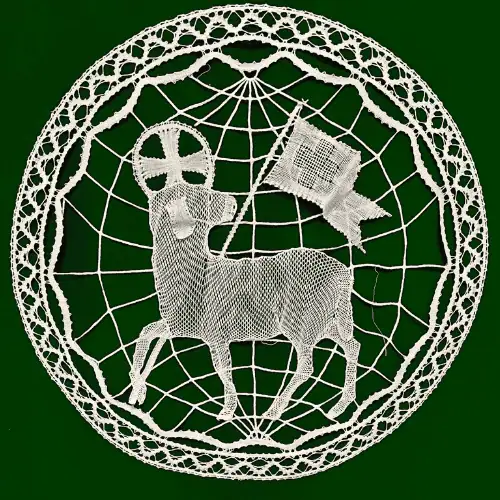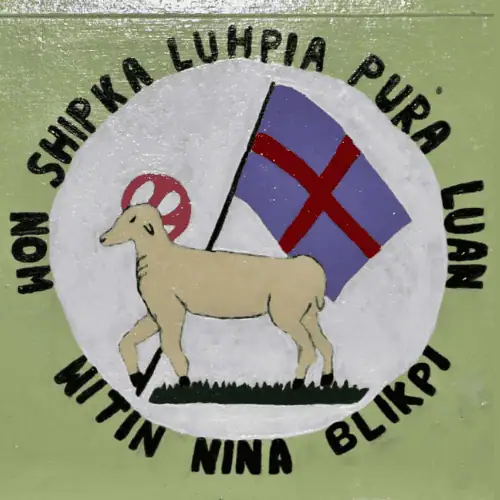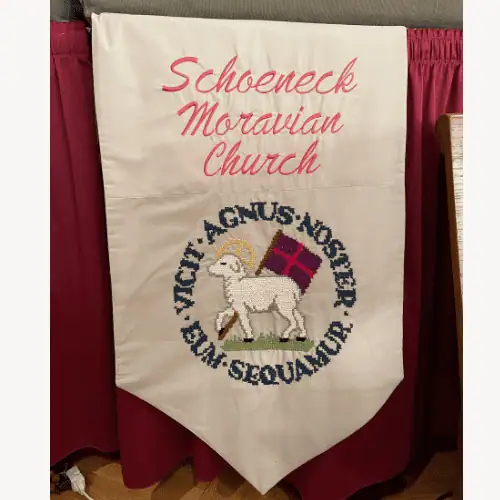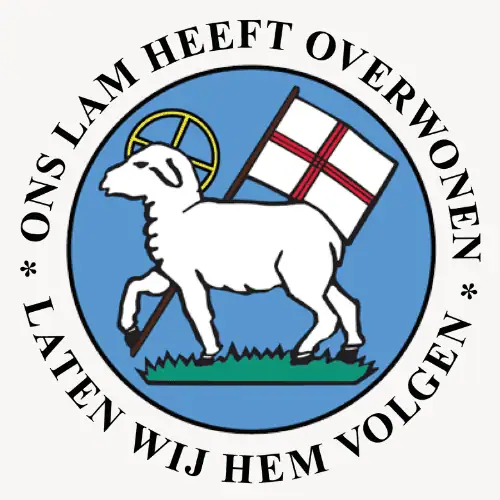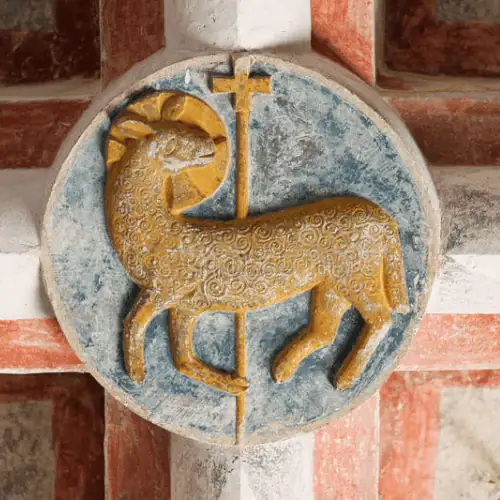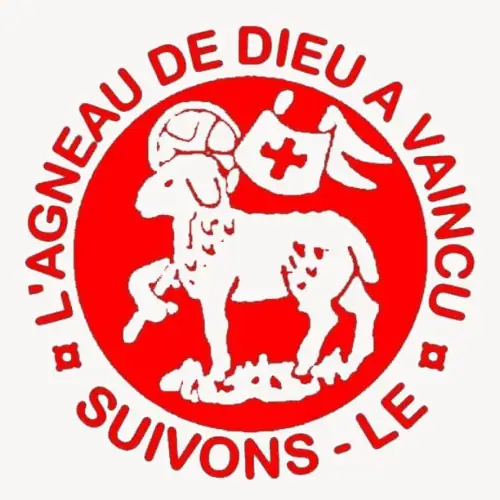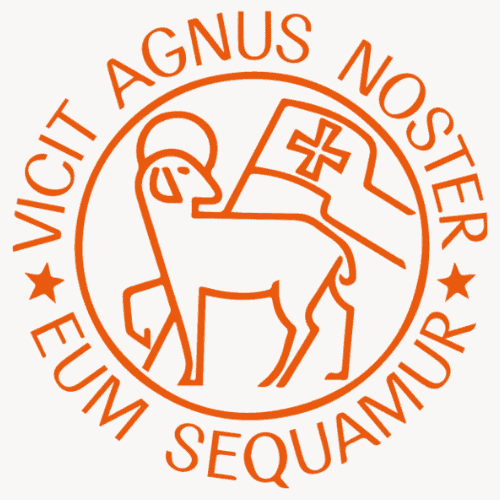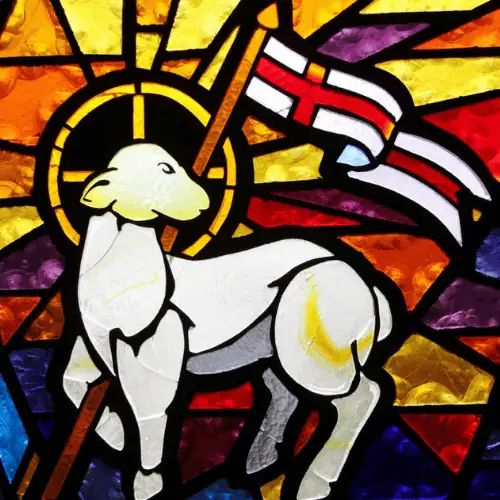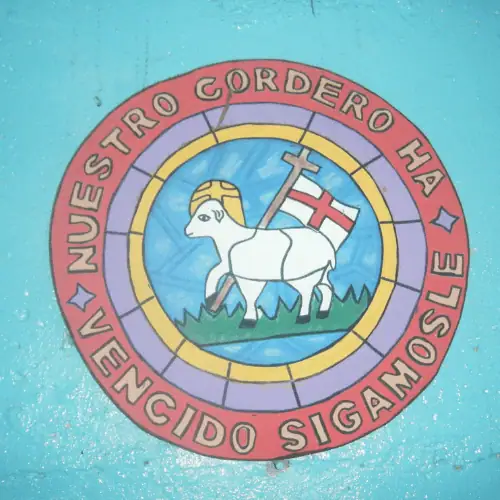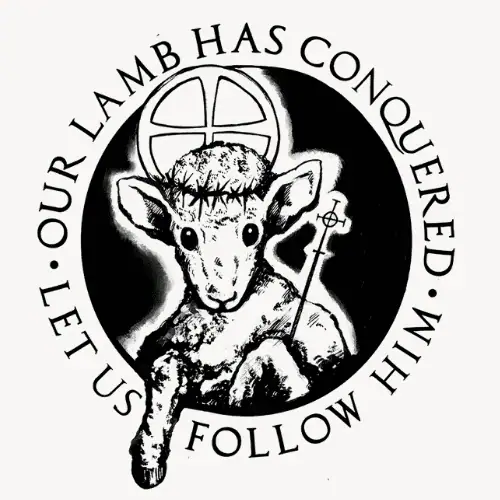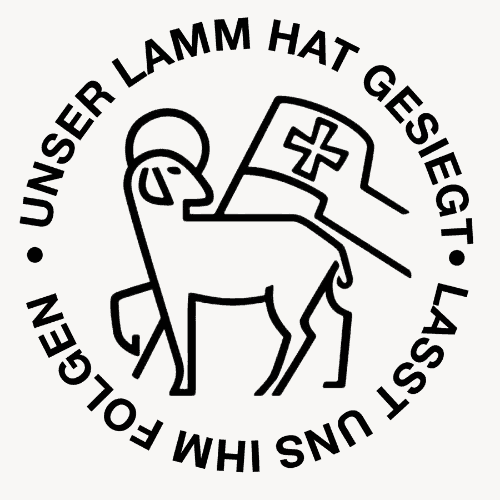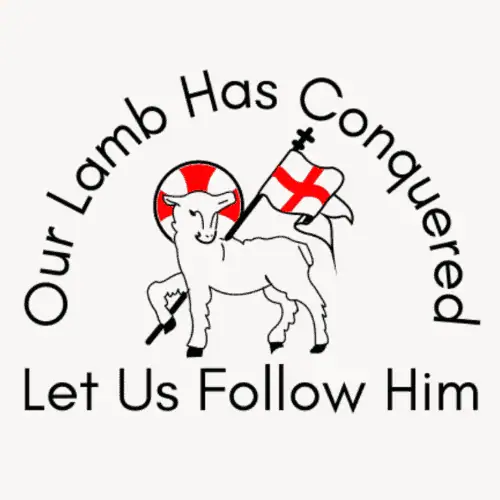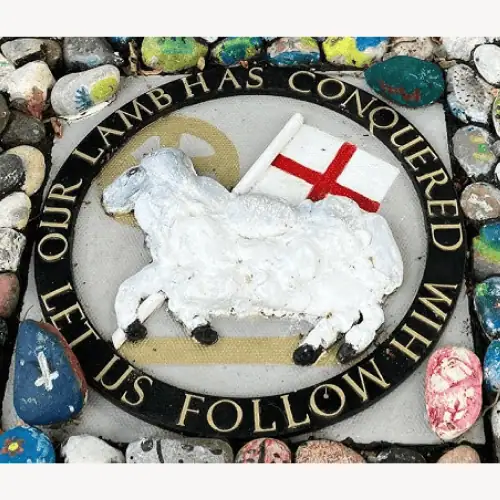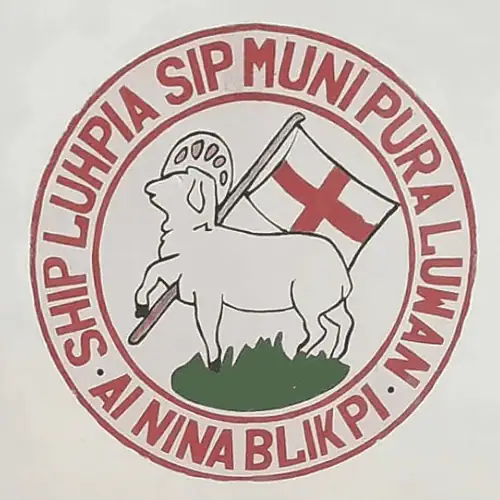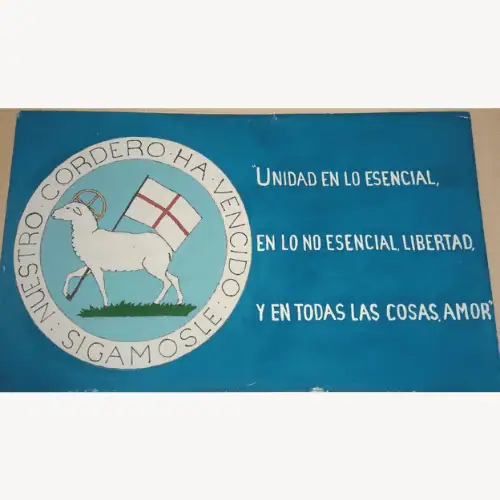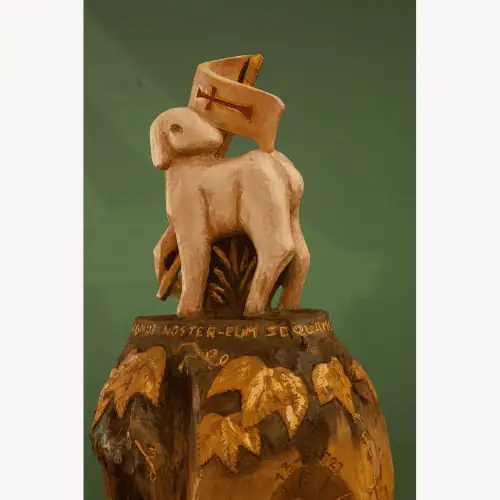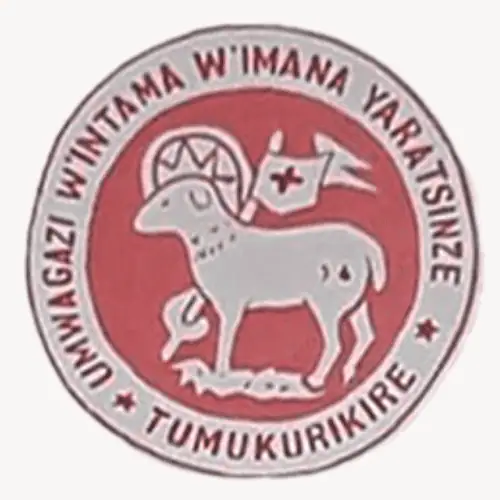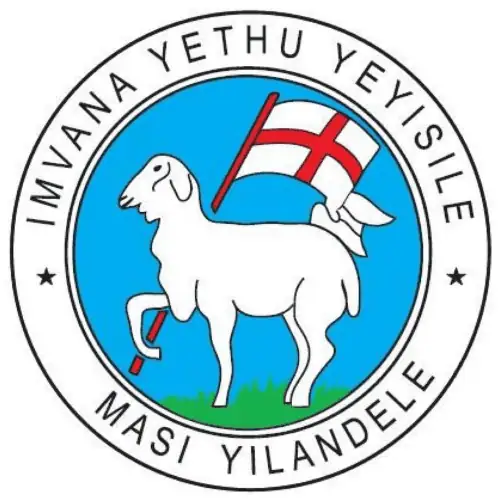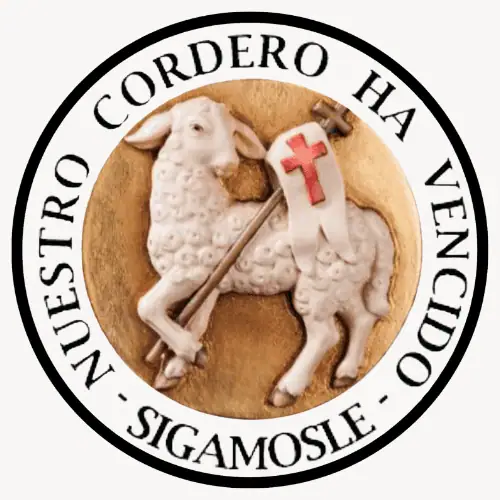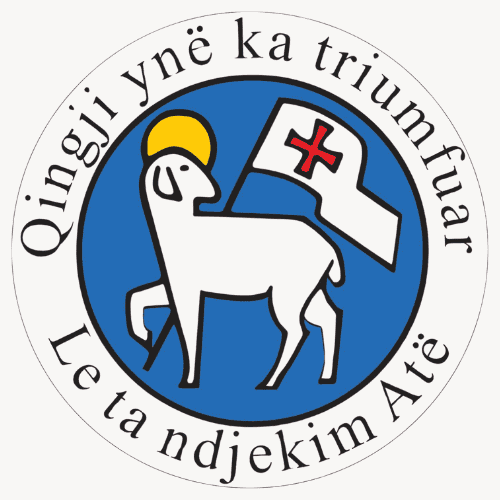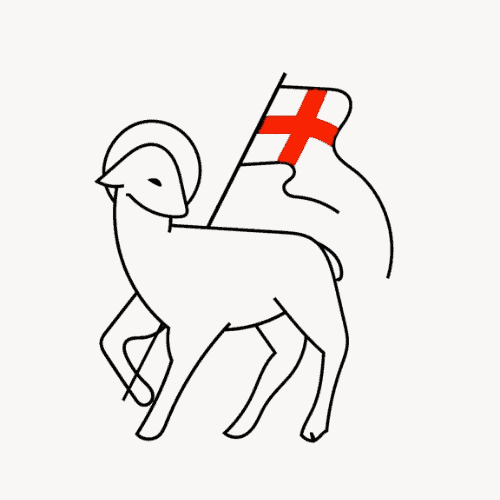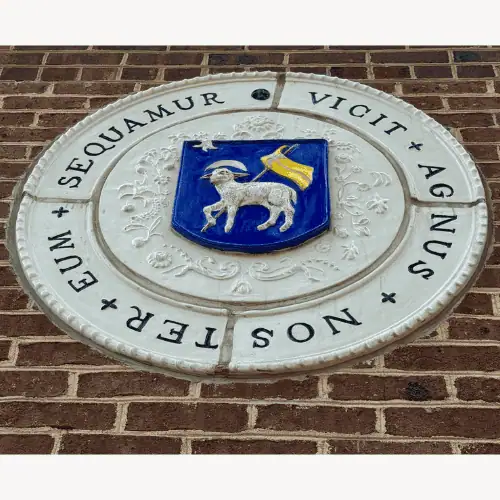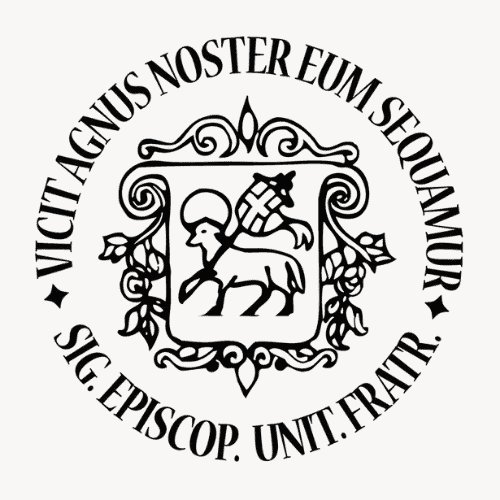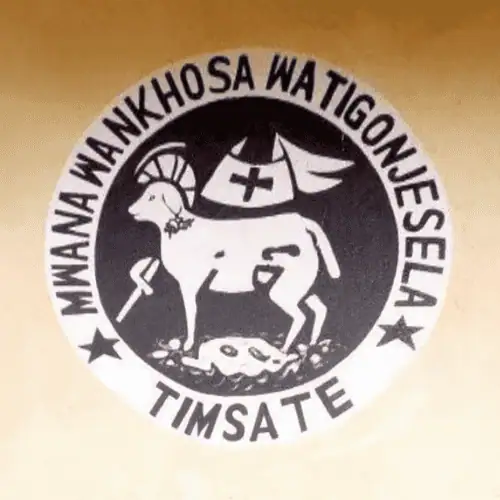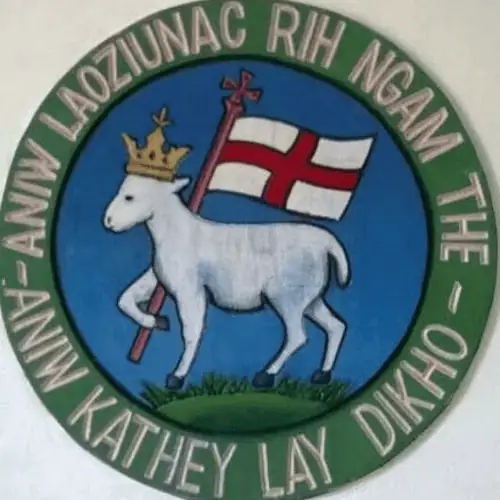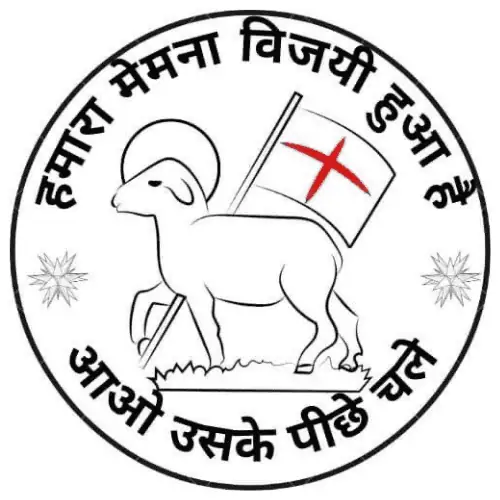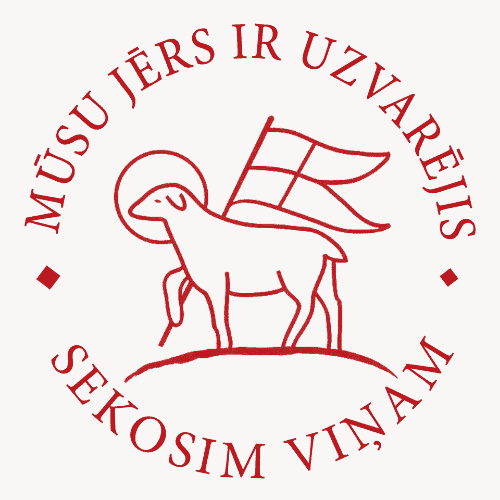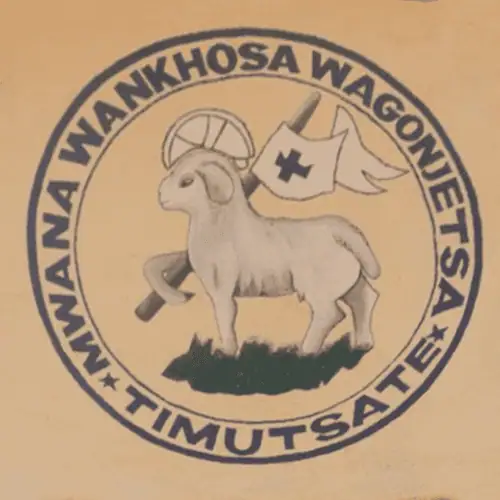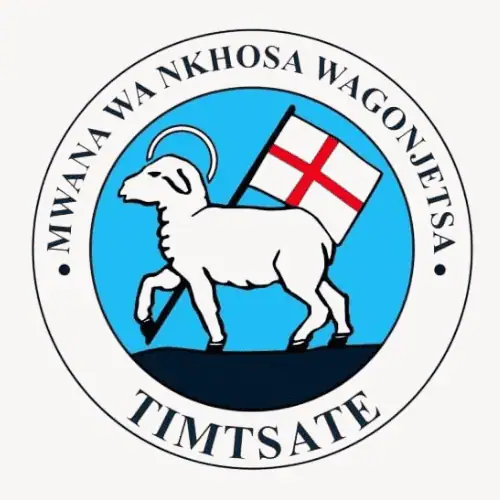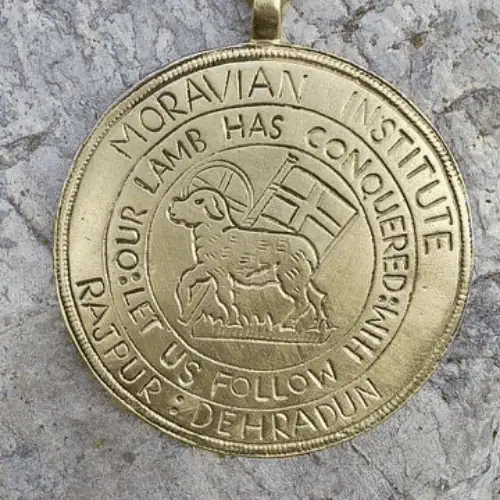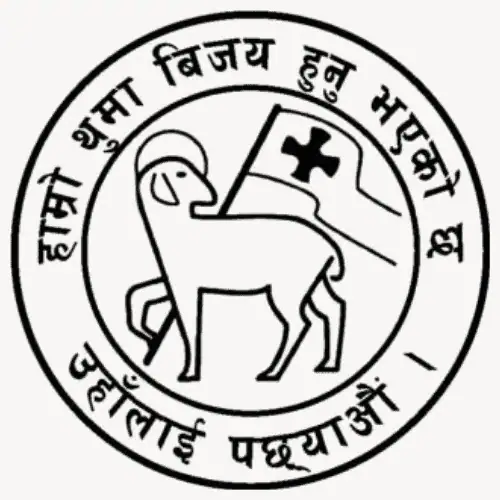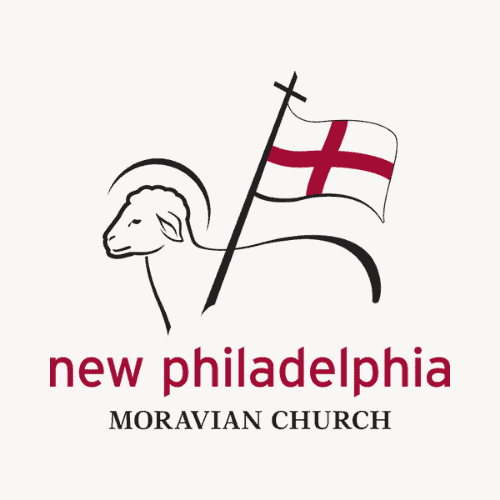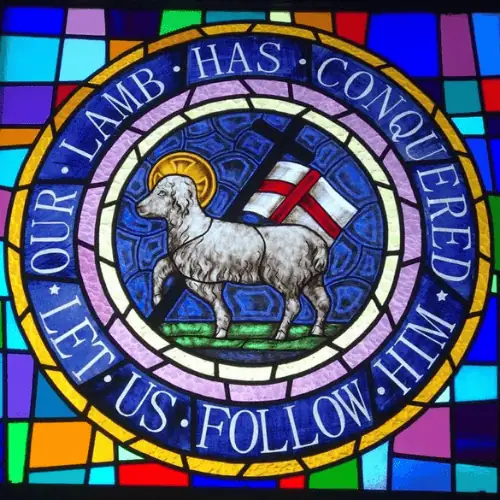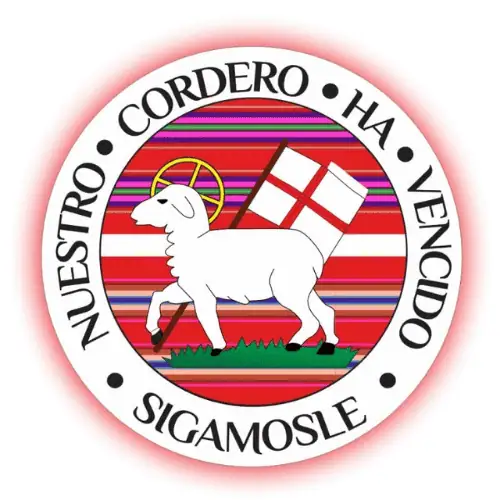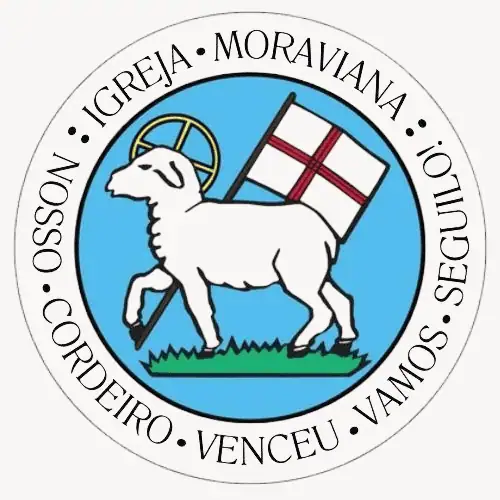The Official Seal of the Moravian Church
The Agnus Dei, a Latin term meaning Lamb of God, is one of the oldest Christian symbols. It was used as a symbol of the Christian church under Emperor Constantine as early as the fourth century. Several mosaics in early churches include it, some showing a row of twelve sheep representing the apostles flanking the central Agnus Dei.
Visually represented as a standing, haloed lamb with one of the forelegs cocked, the Agnus Dei is sometimes facing forward and sometimes faces back. Held in the foreleg and resting on the lamb’s shoulder is a staff, oftentimes with a cross at the top. From the staff waves a white standard with a red cross, though the banner and cross may also be rendered in different colors.
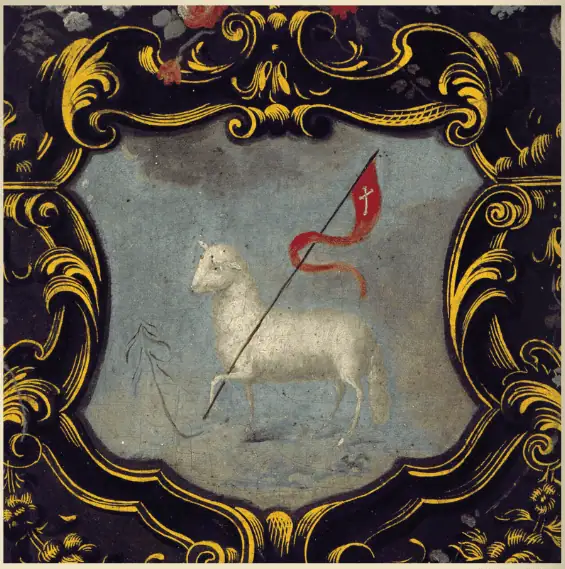
The Agnus Dei is used to refer to Jesus Christ in his role of the perfect sacrificial offering that atones for the sins of humanity, harkening back to ancient Jewish Temple sacrifices. The lamb of the Passover sacrifice is said to prefigure the crucifixion (Exodus 12:21-27). Isaiah calls the expected Messiah the Lamb of God (Isaiah 53:7), and Jesus is met by John the Baptist with the words, “Behold, the Lamb of God, who takes away the sins of the world” (John 1:29). The lamb with the banner represents Jesus Christ and his victory over sin and death.
Jesus chose to suffer death on the cross as a sign of his full obedience to the will of the Father. As the Lamb of God, Jesus Christ is the perfect sacrificial offering that atones for the sins of humanity. The Lamb carries a flag declaring that Christ is victorious in spite of the challenges that he encountered.
The Jablonski Seal
The use of the Agnus Dei as the emblem of the Moravian Church dates to the sixteenth century, possibly earlier. It first appears in a Unity of the Brethren (Bohemian Brethren) hymn book in 1541.
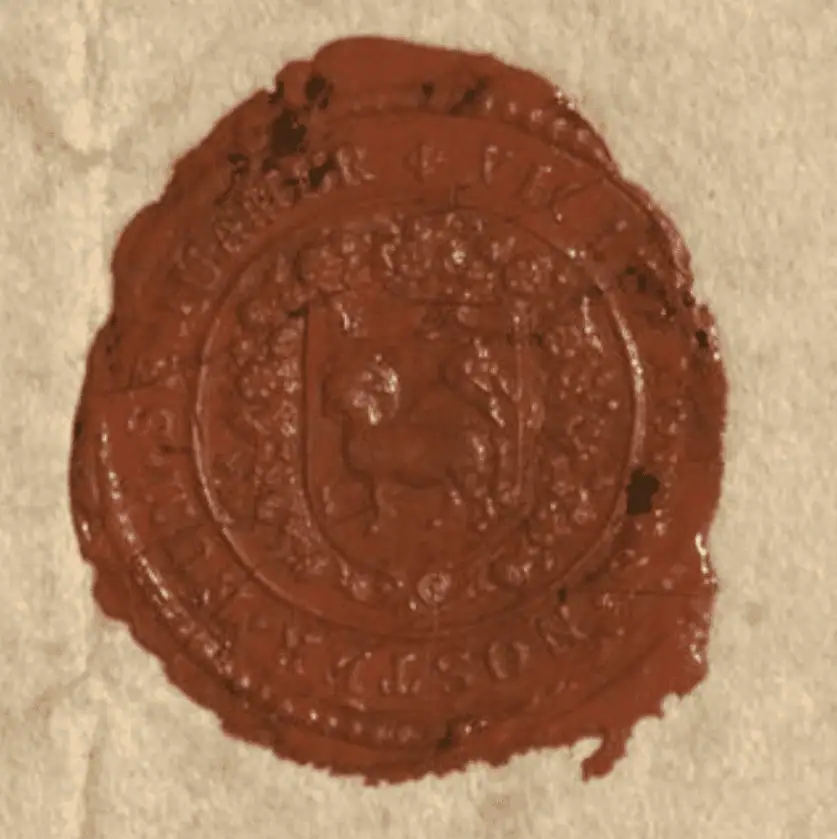
In Berlin on March 13, 1735, Bishop Daniel Ernst Jablonski (1660 – 1741) consecrated David Nitschmann as the first bishop of the renewed Unitas Fratrum. Jablonski was a grandson of Jan Amos Comenius and one of two surviving bishops of the Polish branch of the Unity of the Brethren. This was the transmission of the episcopacy from the ancient Unity to the Renewed Moravian Church.
Bishop Nitschmann’s ordination certificate, dated June 14, 1737 has a wax seal featuring the Agnus Dei with a Latin inscription: Vicit Agnus Noster, Eum Sequamur. This is known as the Jablonski Seal.
The Jablonski Seal is the Official Seal of the Moravian Church and can be found in all Unity provinces. It is a unifying bond of the Moravian Church throughout the world. The Moravian Seal stands in a prominent position in almost every Moravian church sanctuary and is also featured in many other Moravian buildings and institutions. It might be represented in a stained glass window, it might be carved in wood, embroidered on cloth, or it might be painted right on the wall. No matter what form it takes, it’s message is the same. As Moravians, we follow the victorious Lamb of God.
The Official Motto of the Moravian Church
The Jablonski Seal features the official motto of the Moravian Church. Written in a circular band around the Agnus Dei are the words: Vicit Agnus Noster, Eum Sequamur in Latin, which translates to Our Lamb Has Conquered, Let Us Follow Him in English. This is the Official Motto of the Moravian Church, and expresses the Moravian conviction that Christ the Lamb of God is at the center of our faith.
Having gone through so much persecution for its survival, the early Moravians saw our motto as a point of reference and a rallying cry for its followers. Therefore, the victorious Lamb of God is quintessential to the development of our faith.
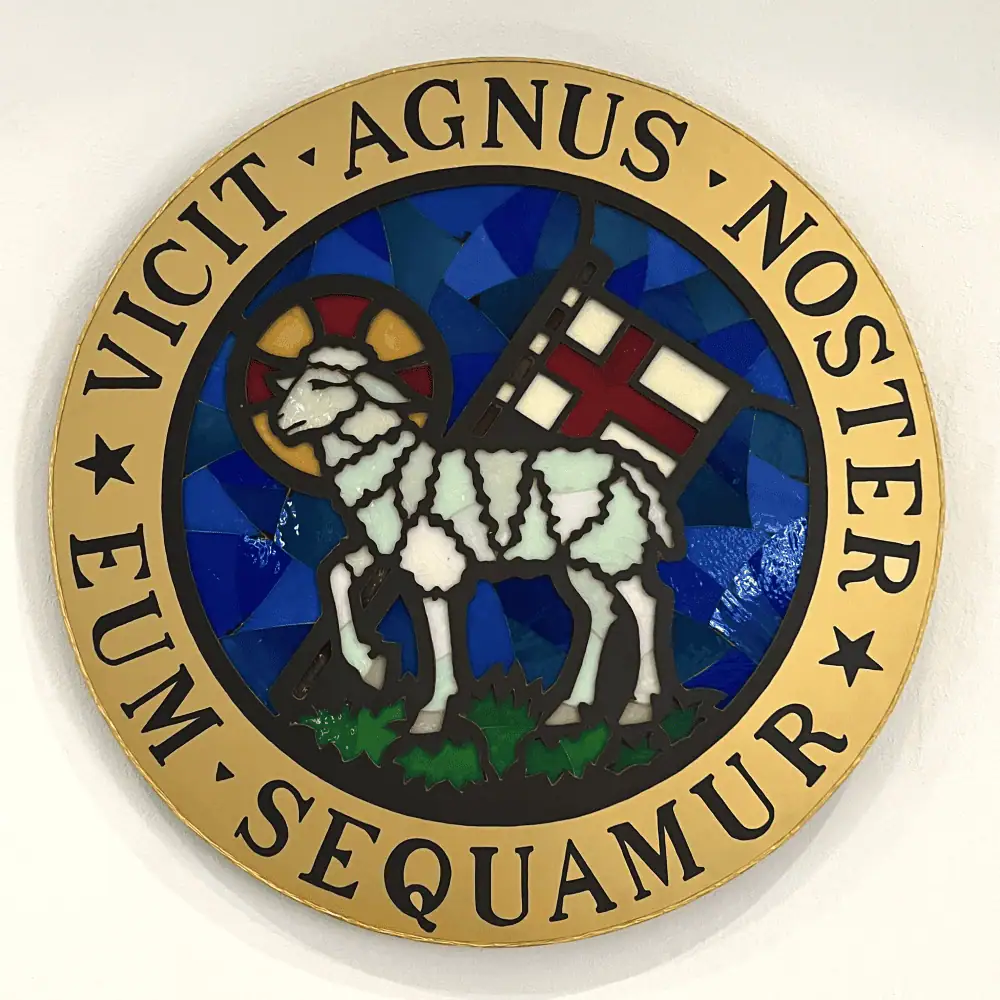
The Moravian Seal and Official Motto focus on the triumph of Christ over death, sin, and the power of evil through His sacrificial death. It combines faith in Christ with active discipleship in following His path of love and service.
As Moravian pastor the Rev. Dr. Cortroy Jarvis wrote in his Moravian Moment #85, “We follow him because he is our all in all; we follow him because he is our champion and great commander. We follow him because he is our healer and great deliverer. We follow him because he is the lover of our souls. We follow him because he is our risen and ascended Lord. We follow him because he is our only hope… We follow him because he is the rose of Sharon, the bright and morning star. We follow because for Jesus the Lamb at the center of the throne is our Shepherd and he will lead us to springs of living water, and because of the victory he has won for us, our tears will be dried and we can live a victorious life.”
Brother Jarvis continues, “You are encouraged therefore to cling to that hope in Jesus Christ, no matter what and remember: Our Lamb has conquered, let us follow him. Moravians everywhere have a mandate to invite men and women to follow Jesus Christ, for we have a testimony of what he has done for our Church and in our lives personally.”
The Guiding Principle of Our Faith
Most institutions in modern society try to express their special characteristics in a logo or brief slogan. For the Moravian Church a phrase that comes closest to this, although never made official, is:
In Essentials, Unity. In Non-Essentials, Liberty. In All Things, Love.
It is often misattributed to Augustine of Hippo but seems to have been first used in 1617 by Archbishop of Split (Spalato) Marco Antonio de Dominis in his anti-Papal De Republica Ecclesiastica. Attributed more frequently to Peter Meiderlin, a 16th century Lutheran theologian, the phrase also appears in the last published work of the Moravian bishop John Amos Comenius entitled The One Thing Needful.
After a lapse of a couple of centuries, the phrase began to appear within the Moravian Church in the mid-1800s, and by 1900 had appeared in the Southern Province’s newspaper, The Wachovia Moravian.
While this principle is not uniquely Moravian, it reflects very well the character of our tradition and has been a comfort and a rallying cry for Moravians around the world.
Therefore, the Moravian Church in America considers “In essentials, unity; in non-essentials, liberty; and in all things, love” to be the guiding principle of our faith.
The significance of this principle is obvious when we consider that the Unitas Fratrum is facing the growing challenge of cultural and theological diversity. At the Unity Synod and other international gatherings, Moravian leaders sometimes struggle to maintain the unity of our church as they disagree on important theological questions. Likewise, many provinces and congregations face the task of dealing with conflicts over matters of doctrine and belief that threaten to divide the community.
The principle ‘In essentials, unity; in non-essentials, liberty; in all things, love’ helps us to see that unity does not mean uniformity. Members of a church community do not need to agree on everything or always have the same opinion. While many people like the idea that others agree with them, our principle makes it clear that in the church there is room for diversity.
Because it is quite unrealistic to expect full agreement among people that come from diverse walks of life, there is great wisdom in the willingness to offer freedom for different views, especially in matters that clearly are of secondary importance. This makes it possible for people to ‘agree to disagree’ and still be part of the same community.
At the same time, the principle ‘In essentials, unity; in non-essentials, liberty; in all things, love’ expresses the wisdom that in those things that are truly important all members of a church community should be of the same mind. Unity means that people are connected to one another by something they all have in common. If this core of essentials is lost, the community falls apart. The ‘essentials,’ are points of agreement that form the core of an organization’s shared identity.
According to the Ancient Unity, founded in 1457, the New Testament tells us clearly what is essential: faith, love, and hope. For Moravians, Christianity is grounded in the living experience of faith in Christ, active love for others, and joyful hope. We believe that this living relationship with Christ is born and nurtured in local faith communities, in relationship with and in service to one another and the world.
A generation later, the Moravians further refined this belief as two essential teachings: First, the essential works of God are creation, redemption (salvation), and sanctification (or blessing). Second, the ways we respond to God’s work are faith, love, and hope. God’s work comes before our response, but the work of God and our response are both essential.
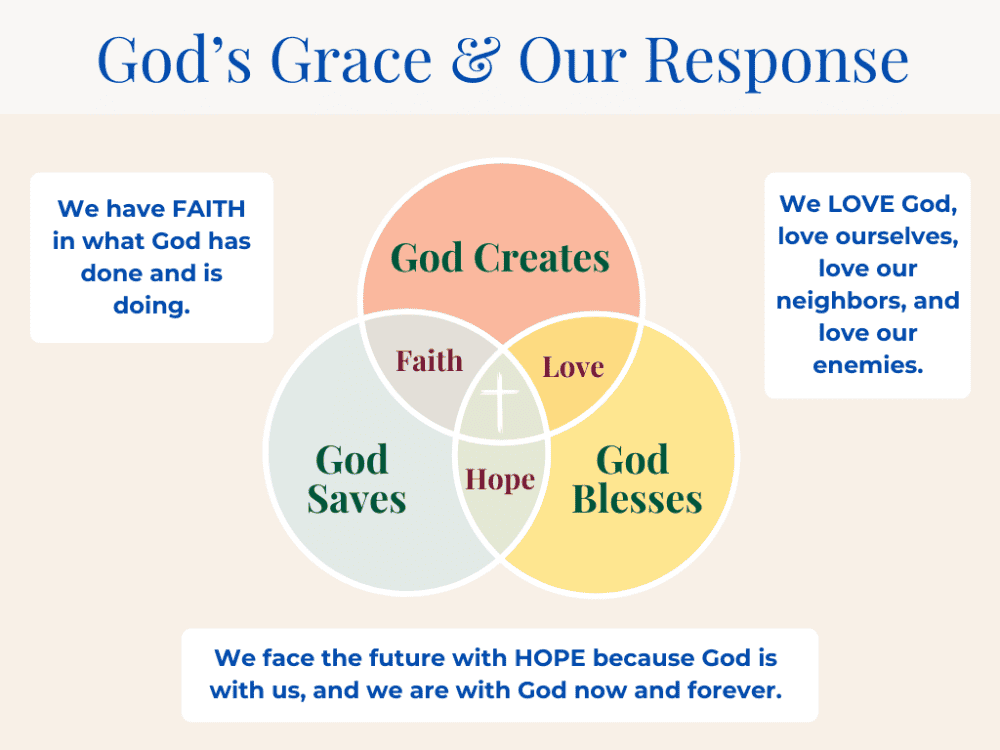
What we can learn from this is to look beyond shared traditions or agreement in doctrine when we think about the essentials of our unity. There is also the reality of God’s grace in creation, the redemptive work of Christ, and the work of the Holy Spirit in our lives, which call forth our response in faith, hope, and love. When we respond to God’s actions, we are in a relationship with God.
Even though there are six essentials, they all work together. Faith is more than simply believing something. It means placing something at the center of your life and relying on it. When we say that we have faith in God, it means that we place our trust in God and God’s work in the world.
GOD CREATES
FAITH means that we really truly believe that God is the creator of all that is and that all God has made is good. It means that we truly believe that the whole world and everyone in it belongs to God.
If we have LOVE for God the creator, it means that we also love all that God has made and treat everything God has made with reverence. If we have faith that all things are made by God and that all things God made are good, and if we love God and God’s work, then we will naturally have HOPE that God’s good work will continue.
GOD REDEEMS
When we say that we have FAITH that God redeems, this means more than simply saying that Jesus is our Savior. It means that we truly believe that it is God who redeems and saves humankind. This is God’s work, not our work. It means that we believe that Christ lived and died for the sake of all people, not just people like us or just for people in our church. It means that we believe deep in our hearts that we are redeemed, which means that we are not slaves to sin.
If we truly believe this, then we will LOVE God with our whole selves because we belong to God. If we truly believe this then we will love others with the kind of love that God has shown in redemption. We will even love strangers and enemies.
And if we live in love and seek to do good for those Christ redeemed, then we will look to the future with HOPE. Perfect love casts out fear, and we have nothing to fear because we know that we are loved with an infinite love. We know that we will be welcomed home by our Savior—along with all those whom Christ has redeemed. This world can become a foretaste of the heavenly kingdom if we live in faith and love.
GOD BLESSES
When we say that we have FAITH that it is God who sanctifies, we are saying more than simply that we believe in the Holy Spirit. It means that we have confidence that our holiness rests in God, not in our own efforts. It means that we truly believe that we have been blessed by God and that God is at work within us to make us better people.
More importantly, it means that we have faith that God also blesses others and makes them holy. If we have faith that God blesses people and makes them holy, then we can respond in LOVE to our families, our friends, our neighbors, strangers, and even our enemies because we know that God blesses others as he blesses us. We can have a deep and abiding HOPE for a better future because we see the Spirit of God at work in the world.
These are the essential things: God creates; God redeems; God blesses. And we respond in faith, in love and in hope. Everything else in the church, whether it is the study of Scripture or the waters of baptism; whether it is the music of angels or the gurgling praise of God on the lips of babies; whether it is profound sermons or a quiet prayer for someone in pain, should be grounded in these essentials.
For over 560 years we Moravians have judged ourselves not by how beautiful our architecture is or how lovely our choirs sing or how eloquent our preachers are or how brilliant our theologians are. We have judged ourselves by how deep our faith is, how expansive our love is, and how life-affirming our hope is.
The Moravian Church Around The World
The official name for the Worldwide Moravian Church is the Unitas Fratrum. As of October 2024, there are now 25 Provinces of the Unity as well as six Mission Provinces (countries and regions that do not have the full status of a Unity province yet) and 15 Mission Areas in which the Moravian Church has only been working for a few years. To see where God is working through the Worldwide Moravian Unity, please click here.
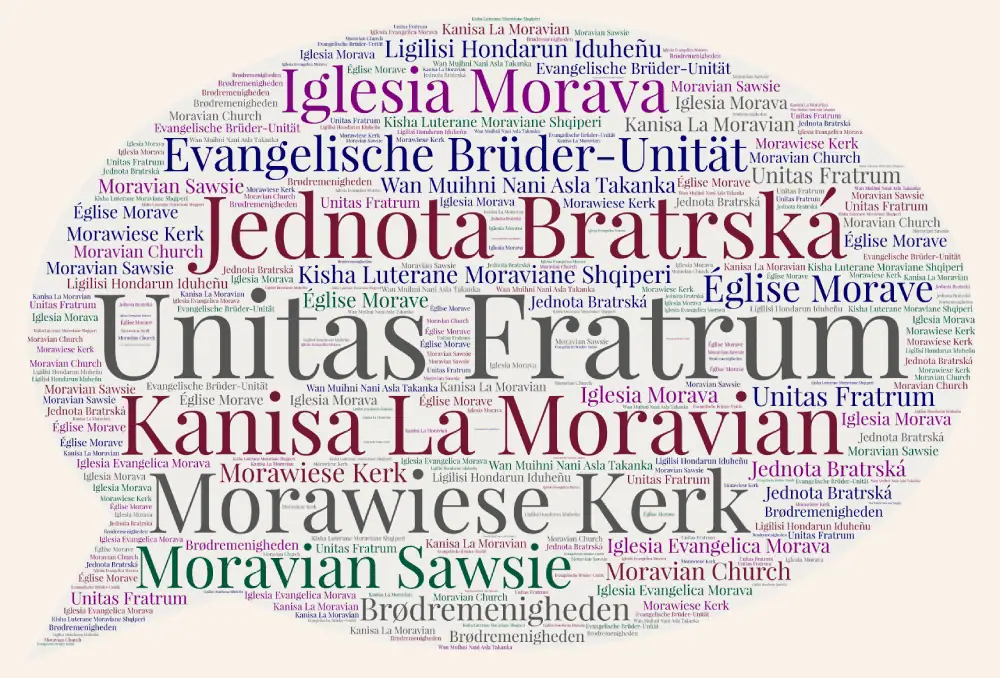
The Provinces of the Unitas Fratrum are found in many areas of the world and among many races and languages. All are indigenous to their geographical and national location. Some are found in highly industrialized communities; others are in developing regions of the world. As a consequence, the Provinces of the Unity offer a wide variety of economic, social and political development.
All Provinces share equally in the common faith, tradition, and witness of the Church. The Savior, through the work of the Holy Spirit, has given each Province gifts which can be of help and blessing to other Provinces of the Unity. The members of all Provinces are in a relationship with one another. The goal set before each Province is to fulfill the calling of Christ in its life, worship, witness, and organization.
The 2017 Unity Moravian Missions Conference displayed the diverse face of the worldwide Moravian Church. The group of 200 or so participants included representatives from 35 different nations and many different languages. Yet, for all the diversity in the Moravian church, what we are known for the most is not so much our differences, but what we have in common — our unity.
The Unitas Fratrum cherishes its unity as a valuable treasure entrusted to it by God. It stands for the oneness of all humankind given by the reconciliation through Jesus Christ. Therefore, the ecumenical movement is of its very lifeblood. For over five centuries it has pointed towards the unity of the scattered children of God that they may become one in their Lord.
The Moravian Seal Around The World
The Moravian Seal can be found in all Unity provinces, too — it is a unifying bond of the worldwide Moravian Church. Of course, one of the basic tenets of the founding of the church is John Huss’ assertion that the church mass should be preached in the language of the people, and the Bible should also be printed in the language of the people. It follows then that the Moravian Motto would also be printed in the language of the people.
Wherever you see the Moravian Seal — whether you are from the United States, Germany, the Czech Republic, Tanzania, South Africa, Peru, or Nicaragua — you know what the inscription says, no matter what language it is written in. The most common language for the seal is Latin.
Moravian Seals also come in many forms — stained glass, fabric, wood carvings, painted on the wall, ceramics, mosaics. Whether the design is simple or more complex doesn’t matter. Moravians are only limited by their creativity, and we are a creative bunch!
Please click on the gallery below to see Moravian Seals from around the world. Every effort has been made to properly identify the location and language of the seal. If you see an error, please send an email to: [email protected]. Thank you!
FUN FACT: Before Schoeneck received it’s current Moravian seal, the Moravian Seal was painted on the wall of the pulpit with the words “Christ, and Him Crucified” above it in an arc.

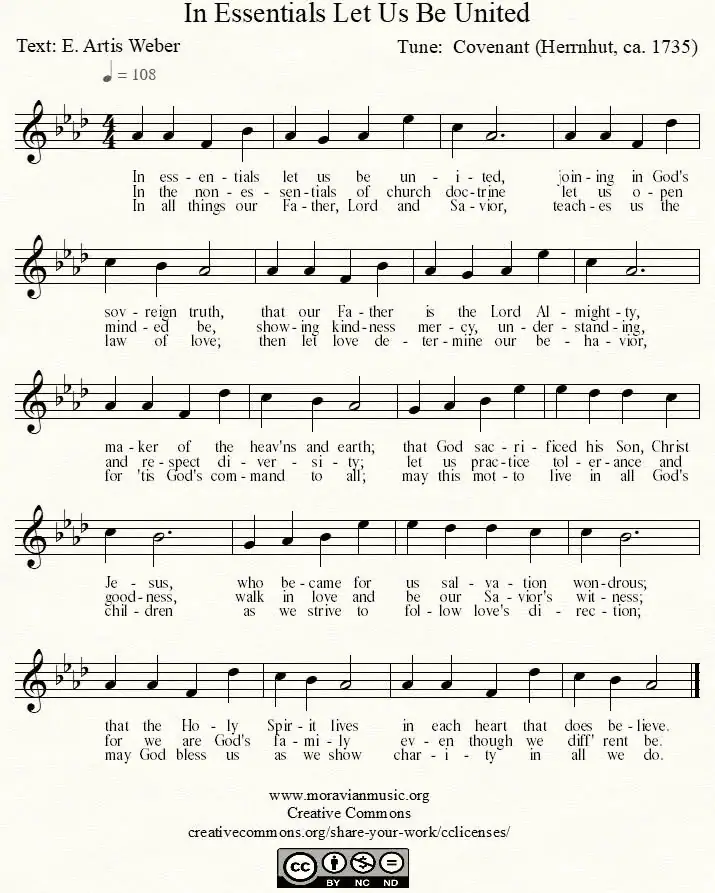
Some information on this page has been taken from the Moravian Church In America website. Copyright © 2010-2025, Interprovincial Board of Communications, Moravian Church in America. All Rights Reserved.
Some information on this page is from “Moravian Moment #178 — Our Lamb Has Conquered” written by Rev. Dr. Cortroy Jarvis, August 15, 2010. Copyright © 2025 The Moravian Church – Eastern West Indies Province. All Rights Reserved.
Some information on this page is from “Moravian Moment #85” written by Rev. Dr. Cortroy Jarvis, September 14, 2008. Copyright © 2025 The Moravian Church – Eastern West Indies Province. All Rights Reserved.
Some information in the “The Guiding Principle” section of this page is taken from the article “‘In essentials, unity…’ A view of the ‘Moravian Motto’”on the Moravian.org website. To read the full article, please click here. The article itself is adapted from “Our Moravian Treasures: A Manual of Topics for Theological Education in the Unitas Fratrum,” edited by the Reb. Dr. Peter Vogt. Copyright © 2020, Interprovincial Board of Communication, Moravian Church in America. All Rights Reserved.
Some information in the “The Guiding Principle” section of this page is taken from “Living the Essentials” by the Congregational Support Working Group, Board of Cooperative Ministries, Moravian Church Southern Province. Copyright © 2015. All Rights Reserved. To read the full article, please click here.
Some information in the “The Guiding Principle” section of this page is taken from the article “In Essentials, Unity: Understanding the Essential Things” written by the Rev. Dr. Craig D. Atwood on the Moravian.org website. To read the full article, please click here.
Some information in the “The Moravian Seal Around This World” section of this page is from “Moravian Moment #16 — The Extent of the Moravian Church” written by Rev. Dr. Cortroy Jarvis, April 29, 2007. Copyright © 2025 The Moravian Church – Eastern West Indies Province. All Rights Reserved.
The hymn “In Essentials Let Us Be United” can be found in the Moravian Book of Worship, Hymn #397. Text: E. Artis W. Weber (1998, rev. 1993). Copyright © 1993 E. Artis W. Weber. Used by permission. Tune: Herrnhut (c. 1735) C. Gregor, Choralbuch (1784). Copyright © 1995, Interprovincial Board of Communications, Moravian Church in America. All Rights Reserved.
Photo Credit: Close-up of the Jablonski Seal from the “Certificate of the consecration of Bishop David Nitschmann” Ref. No. PP ND (Ep.) 16.1 © Moravian Archives, Bethlehem, Pennsylvania. All Rights Reserved.
